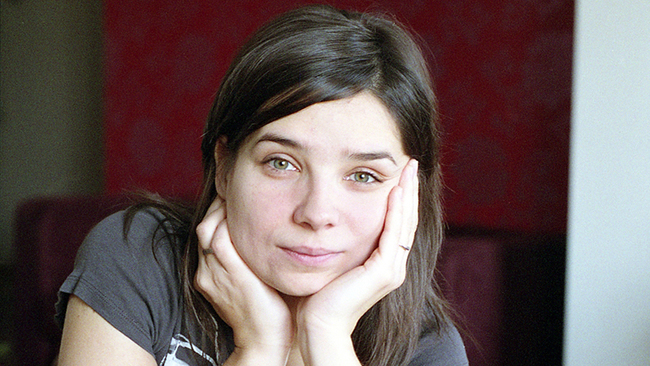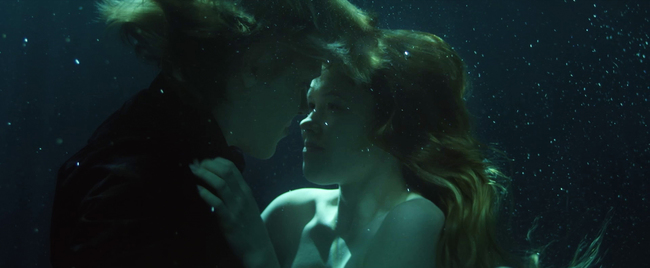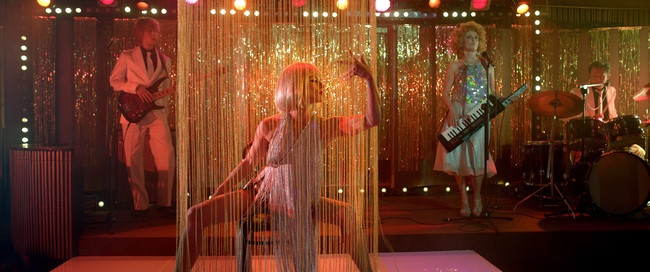Siren Song: An Interview with Agnieszka Smoczyńska

In her just-released Sundance hit The Lure, Agnieszka Smoczyńska evokes both the decadence and decrepitude of 1980s Poland through the adventures of Silver and Gold, two man-eating mermaid sisters who decide to go terrestrial and soon become a nightclub singing sensation. Drawing inspiration from the dark fairy tales of Hans Christian Andersen, the visceral pleasures of genre filmmaking, and the director’s own childhood memories of Communist-era Poland, Smoczyńska’s debut feature is a provocative, extravagantly imagined take on the female coming-of-age story. In anticipation of its theatrical premiere this week at New York’s IFC Center, Brian Belovarac of Janus Films chatted with Smoczyńska over email (with the help of translator Izabela Grocholski) about Polish nightclubs, female puberty, and mer mythology.
The film’s primary setting is the dance hall in which Silver and Gold perform. What made the “dancing restaurants” of the 1980s different from regular nightclubs?
Under Communism, dancing restaurants were very popular. They were places where people came to enjoy live performances of Polish and American hits played by great musicians. On Fridays and Saturdays, there were special programs with an emcee, a stripper, a magician, and a band, and people could dance in pairs. The dancing restaurant culture was typical for Eastern Bloc countries. It was a world where one could escape politics. The dancing connected people from different spheres—bureaucrats, directors, cabdrivers, and bankers would all go there to have a good time. Dancing restaurants also had better food, like meat, Coca-Cola, good vodka, cognac—things one couldn’t buy in grocery stores. It was a peek into a better, Western world.
Was the film envisioned as a musical from the start?
No. At first the story was supposed to be a simple psychological drama—a biography of the Wrońska sisters, [Barbara (Basia) and Zuzanna (Zuzia)], with whom our screenwriter, Robert Bolesto, was friendly and whose parents performed at dancing restaurants. Their childhoods were full of vodka, parties, and absent parents, which Basia felt uncomfortable exposing. We were certain that the project would fall apart, but Robert said, “Instead of two girls, let the two main characters be mermaids.” That was so absurd that Basia agreed, and the mermaids became masks behind which the girls could hide. Since mermaids sing and the film takes place in a nightclub, it automatically became a musical, and since our mermaids were related to Homer, they devoured people, making the movie a horror film as well.

What was it about the mythology of the mermaid that appealed to you?
When I was small, my mother used to tell me about myths rather than fairy tales. I remember mermaids who lost a battle with Orpheus, who drowned out their song with his harp music; they threw themselves into the sea from a cliff and transformed into sea foam. I also remember another myth in which mermaids were guides of souls; they accompanied people in the last moments of their lives. When we looked deeper into the mythology of mermaids, we noticed that mermaids were often portrayed as evil, wild, and predatory. In our myth, the mermaid is a voracious but sensitive being who tries to follow the principles of the human world and loses her own identity.
You’ve described the film as an “adult fairy tale.” Did you feel like you were working with themes that were already present in the Hans Christian Andersen story?
Our story is Hans Christian Andersen’s in that it speaks about the impossibility of the love of a mermaid for a human being, but for us the mermaid became a metaphor for a girl who is not yet a woman. The goal of the film was to remind one of the feelings and the experiences associated with puberty: the first menstrual period, the first cigarette, the first drink, the first sexual encounter, and the first romantic obsession, which for you is everything and shapes your identity. It seems to you that once it disappears, you will disappear with it.
You’ve also described the film as very personal, having spent so much time in the restaurants your mother managed while you yourself were coming of age. How did your memories shape the film?
I spent my childhood in the back rooms of dancing restaurants in Szklarska Poręba and in Kowary that were run by my mother. Through the wall I could hear the beat of the live music. During the breaks, the sweating musicians in their sequined jackets would sit in the small dressing room, pulsating with a highly erotic energy. On the dance floor, beautiful, perfumed women would be dancing—they were elegant, and sometimes increasingly drunk. Thin waiters would bustle about in between guests. Men in suits after several hours of drinking would start to move slowly. Toward the early hours I would be woken by voices of the last people to leave the place and the emptiness that remained after them, just like in the song: “Drunk, lonely, supporting the bar / Drunk, lonely, supporting the walls.”

The look and feel of the nightclub is very different from the drab offstage world the human characters inhabit. How did you work with your production designer and cinematographer to delineate those spaces?
I gave the cameraman, [Jakub] Kijowski, the screenplay in one hand and a CD with the Wrońska sisters’ songs in the other hand. Once he heard the dissonance between the psychedelic lyrics of the songs and the violent text of the screenplay, he began to understand the film as a series of dualities: that which is bestial and that which is human, and that which is naive and that which is brutal. We were looking for a way to present the world like a nightclub: on the one hand, enchanting and dazzling, and on the other, dirty and putrid.
Design-wise, the point of departure for us was the art of [Aleksandra] Waliszewska, who paints perverse takes on fairy-tale characters for adults. With the set designer, [Joanna] Macha, we wanted the viewers to move with the characters from the underwater world to the pulsating world of the city. [Joanna] used reflections of mirrors and refraction of lights to create the world of the nightclub, as opposed to the girls’ home, which was meant to be monochromatic and sad. We were also inspired by the photos of Nan Goldin, who speaks of a world that is also beautiful, vulnerable, and naked, but very much for adults.
How did you direct your “mermaids”?
A few months before shooting, with trainers and on our own, we would go over the entire screenplay with the girls, scene after scene, in order to lay it out in our heads. We would play out the scenes that were meant to be the most difficult emotionally and physically. It was not our intention to rehearse dialogue but rather to mobilize the relevant emotions and mechanics of the body: how it feels not to have legs, how it feels to be an animal in a world of humans. This was useful more than once on set, especially when working with Marta [Mazurek]. I would ask her, “Do you remember what happened in rehearsal?” and that would trigger her memory from her training sessions. For Michalina [Olszańska], the most difficult scenes were those that demanded psychological candor. The girls came from different worlds. This is why I am happy that now they have a closer relationship—like sisters.



